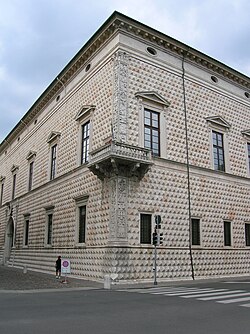
Ferrara is a city and comune (municipality) in Emilia-Romagna, Northern Italy, capital of the province of Ferrara. As of 2016, it had 132,009 inhabitants. It is situated 44 kilometres northeast of Bologna, on the Po di Volano, a branch channel of the main stream of the Po River, located 5 km north. The town has broad streets and numerous palaces dating from the Renaissance, when it hosted the court of the House of Este. For its beauty and cultural importance, it has been designated by UNESCO as a World Heritage Site.

Giovanni di Niccolò de Luteri, better known as Dosso Dossi, was an Italian Renaissance painter who belonged to the School of Ferrara, painting in a style mainly influenced by Venetian painting, in particular Giorgione and early Titian.

Francesco del Cossa was an Italian Renaissance painter of the School of Ferrara, who after 1470 worked in Bologna. Cossa is best known for his frescoes, especially his collaboration with Cosimo Tura on a cycle of the months in the Palazzo Schifanoia of the Este family, rulers of Ferrara. Otherwise, his paintings are mostly of religious subjects, with some portraits and drawings attributed to him. He also designed stained glass.

Benvenuto Tisi, also known as Il Garofalo, was a Late-Renaissance-Mannerist Italian painter of the School of Ferrara. Garofalo's career began attached to the court of the Duke d'Este. His early works have been described as "idyllic", but they often conform to the elaborate conceits favored by the artistically refined Ferrarese court. His nickname, Garofalo, may derive from his habit of signing some works with a picture of a carnation.

Biagio Rossetti was an Italian architect and urbanist from Ferrara. A military engineer since 1483, and the ducal architect of Ercole I d'Este, in 1492 Rossetti was assigned the project of enlarging the city of Ferrara.
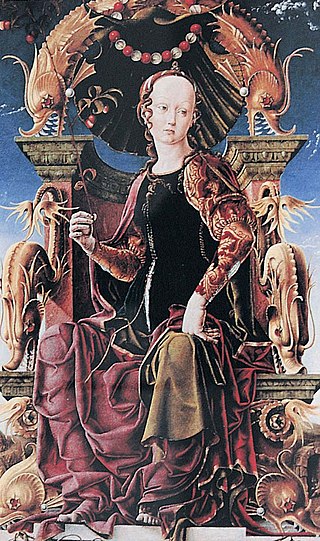
Cosmê Tura, also known as Il Cosmè or Cosimo Tura, was an Italian early-Renaissance painter and considered one of the founders of the School of Ferrara. He provided a great contribution to the Renaissance in Ferrara.
The School of Ferrara was a group of painters which flourished in the Duchy of Ferrara during the Renaissance. Ferrara was ruled by the Este family, well known for its patronage of the arts. Patronage was extended with the ascent of Ercole d'Este I in 1470, and the family continued in power till Alfonso II, Ercole's great-grandson, died without an heir in 1597. The duchy was then occupied in succession by Papal and Austrian forces. The school evolved styles of painting that appeared to blend influences from Mantua, Venice, Lombardy, Bologna, and Florence.

Palazzo Schifanoia is a Renaissance palace in Ferrara, Emilia-Romagna (Italy) built for the Este family. The name "Schifanoia" is thought to originate from "schifare la noia" meaning literally to "escape from boredom" which describes accurately the original intention of the palazzo and the other villas in close proximity where the Este court relaxed. The highlights of its decorations are the allegorical frescoes with details in tempera by or after Francesco del Cossa and Cosmè Tura, executed ca 1469–70, a unique survival of their time.
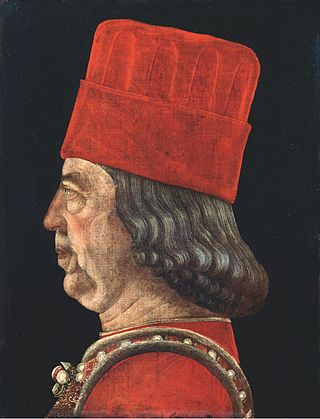
Borso d'Este was the duke of Ferrara the first duke of Modena, which he ruled from 1450 until his death. He was a member of the House of Este.

Ercole de' Roberti, also known as Ercole Ferrarese or Ercole da Ferrara, was an Italian artist of the Early Renaissance and the School of Ferrara. He was profiled in Vasari's Le Vite delle più eccellenti pittori, scultori, ed architettori. The son of the doorkeeper at the Este castle, Ercole later held the position of court artist for the Este family in Ferrara. According to Vasari:
Ercole had an extraordinary love of wine, and his frequent drunkenness did much to shorten his life, which he had enjoyed without any accident up to the age of forty, when he was smitten one day by apoplexy, which made an end of him in a short time.
The decade of the 1460s in art involved some significant events.
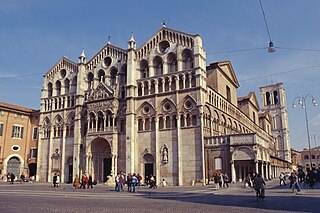
Ferrara Cathedral is a Roman Catholic cathedral and minor basilica in Ferrara, Northern Italy. Dedicated to Saint George, the patron saint of the city, it is the seat of the Archbishop of Ferrara and the largest religious building in the city.

The Galleria Estense is an art gallery in the heart of Modena, centred around the collection of the d’Este family: rulers of Modena, Reggio and Ferrara from 1289 to 1796. Located on the top floor of the Palazzo dei Musei, on the St. Augustine square, the museum showcases a vast array of works ranging from fresco and oil painting to marble, polychrome and terracotta sculpture; musical instruments; numismatics; curios and decorative antiques.

Palazzo Prosperi-Sacrati is a Renaissance-style palace located on Corso Ercole I d'Este in Ferrara, region of Emilia Romagna, Italy. The palace with its protruding marble portal and balcony, and with a corner balcony and pilaster on the corner with Corso Biagio Rossetti, was designed and built in 1493-1498 by Biagio Rossetti as part of the Addizione Erculea. It is flanked on the ground floor by marble pilasters. It is across the Corso Rossetti from the lateral facade of the Palazzo dei Diamanti.
The Studiolo of the Palazzo Belfiore was a former study, or room for intellectual pursuits, that was once found in a razed Renaissance palace in Ferrara, region of Emilia-Romagna, Italy. While the palace has disappeared, records do list the paintings, consisting of depictions of muses, that hung in the room. These secular works are now dispersed across museums, but their collective presences recall the renewed attention of Renaissance patrons to symbols from classic mythology.
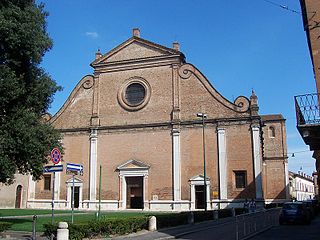
San Francesco is a late-Renaissance, Roman Catholic minor basilica church located on via Terranuova in Ferrara, Emilia-Romagna, Italy.

The Palazzo Loredan Cini is a Gothic-style palace located between the Palazzo Balbi Valier and the Rio San Vio on the Grand Canal, in the sestiere of Dorsoduro, Venice, Italy. The palace was formed from the amalgamation of the former Palazzo Foscari-Loredan with the adjacent Palazzo Grimani. The narrow facade on the Canal has no entrance, but the facade to the north on the Rio, has a single water door, and is connected to the adjacent campo by a bridge. The facade is decorated with two poliforas.
The Gallerie Estensi is a network of three museums and a library, bringing together the collective fruits of artistic production from Ferrara, Modena and Sassuolo in the Emilia-Romagna region of Northern Italy. The galleries aim to preserve the historic heritage left by the influential House of Este, with a focus on relating their past to the local communities at each site.

The Pinacotecta Nazionale is an art gallery in Ferrara, Emilia-Romagna, Italy. It is located on the piano nobile of the Palazzo dei Diamanti, a work of Renaissance architecture by Biagio Rossetti, commissioned by Leonello d’Este in 1447. Not to be confused with the Civic Museum on the lower floor, which has hosted temporary exhibitions of contemporary art since 1992, the Pinacoteca houses a collection of paintings by the Ferrarese School dating from the thirteenth to the eighteenth centuries. It was founded in 1836 by the Municipality of Ferrara after Napoleon's widespread dissolution of churches threatened the protection of important public artworks. The gallery is formed as much around notable northern Italian painters as it is around the exquisite interior decoration of the palace itself, together with remnants of frescoes from local churches and later acquisitions from the Sacrati Strozzi collection.
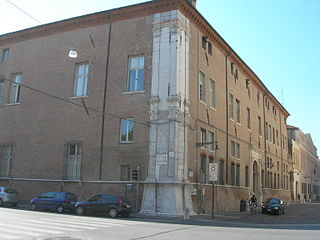
The Palazzo Turchi di Bagno is a historical palace in Ferrara at Corso Ercole I d'Este 32.
